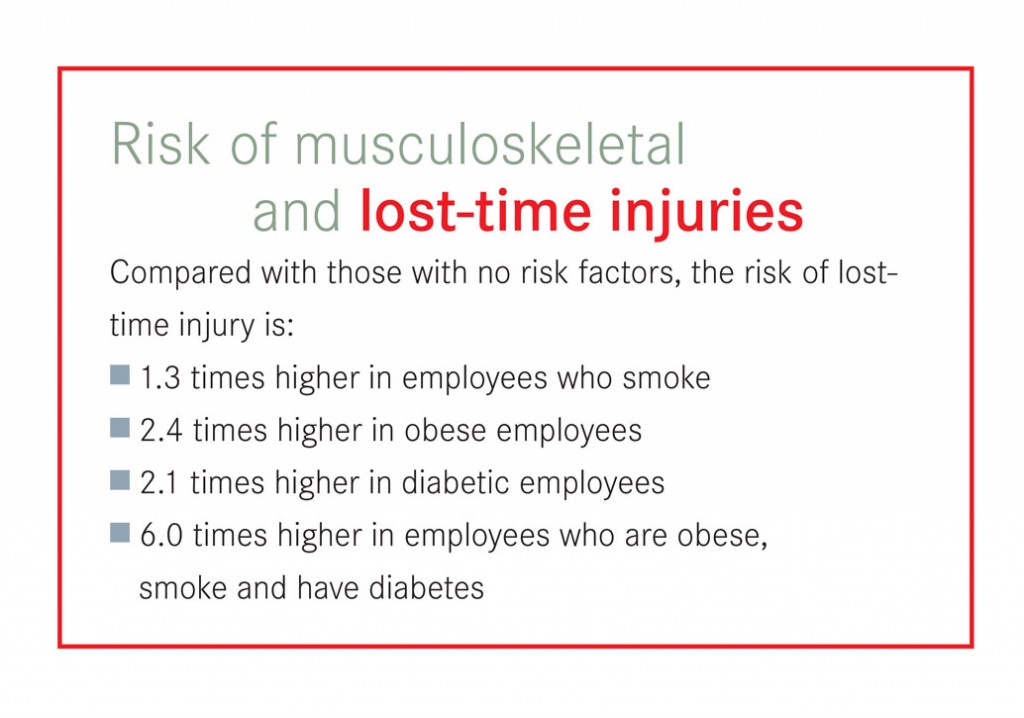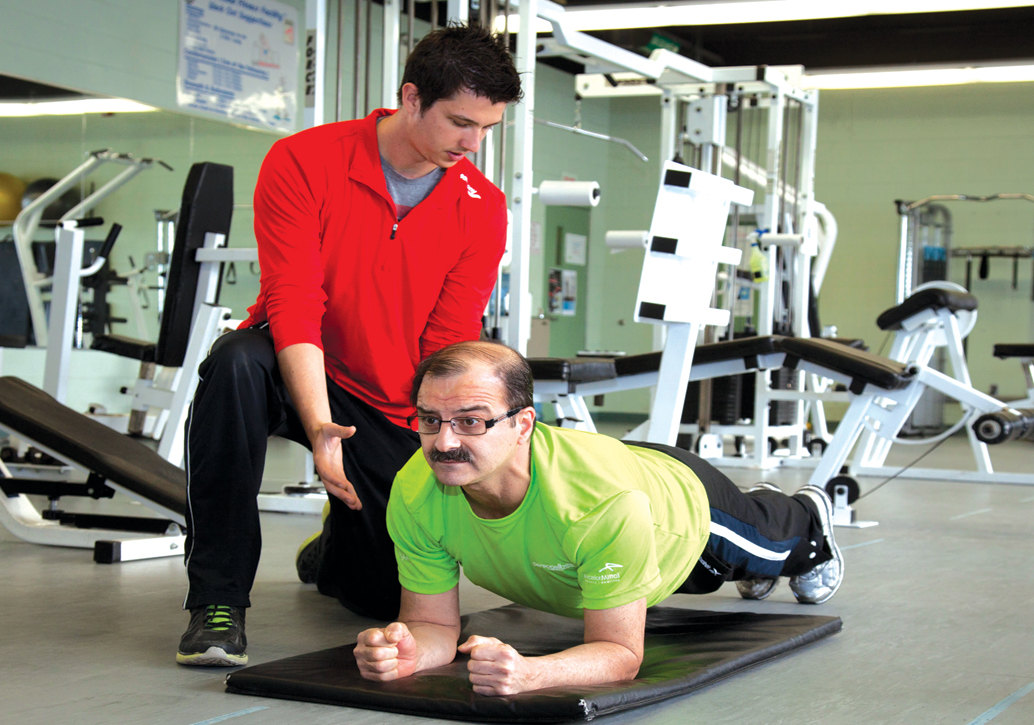Injury prevention program: Decreasing the risk of musculoskeletal injuries
By Ryan Wight, RKin, CEP
Employee wellness programs have one simple goal: To provide employees with services to improve their well-being. However, the various approaches to improved well-being are, multifaceted, designed to incorporate health, fitness and wellness initiatives. The manufacturing sector has seen a transition as employees who once worked in very physically demanding jobs are now more sedentary working in monitoring roles with automated and highly technical equipment. Tasks that were once completed manually are now largely automated. In addition, the Canadian work force is aging, which brings its own challenges. With increased inactivity and age, health risks are on the rise. Within this particular demographic, internal studies completed at ArcelorMittal Dofasco —a manufacturer with more than 5,000 employers, with approximately 70 per cent of the workforce in hourly plant-based roles.—have shown a correlation between modifiable health risk factors and lost time at work.
Furthermore, obesity rates continue to climb throughout Canada and are at alarming rates in the industrial sector. Obesity is known to be associated with an increased prevalence of type 2 diabetes, cardiovascular diseases and some forms of cancer. Within the workplace, obesity also correlates with a higher risk of musculoskeletal injuries and thus results in a higher number of lost-time injuries (LTIs).
Ten-year study
At ArcelorMittal Dofasco, an internal, 10-year longitudinal study found that employees who smoked had 1.3 times the risk of LTIs compared with those with no modifiable health risk factors. Obese employees were at 2.4 times the risk, while the risk was increased by 2.1-fold in those with diabetes. When obese employees either smoked or had diabetes, their risk increased to 3.0 and 4.5 times greater, respectively, than those with no risk factors. In employees with all three risk factors (i.e., obesity, smoking and diabetes), the risk escalated to 6.0 times greater than those with no risk factors. Occupational lost-time claims cost Canadian companies an estimated $60,000 per claim, while non-occupational lost-time claims still cost a company an estimated $20,000 per claim. The company realized that a reduction in LTIs could therefore save it hundreds of thousands of dollars.
ArcelorMittal Dofasco decided to focus on a proactive approach of reaching out to employees before they experienced an injury. It was hypothesized that by decreasing the number of sedentary employees and increasing their strength and function, lost-time claims would be reduced.
Implementation
The company began an initiative to create a healthier workplace culture. The first step was to establish three onsite fitness centres that provided free and easy access to a wide range of exercise equipment. The second step was to bring in a professional health and wellness management company (Health Systems Group) to oversee a healthy lifestyles program, as well as to run the fitness facilities.
With a management staff in place, gaps in services were identified. The most important finding was that the target demographic, hourly plant-based employees, were low users of the onsite fitness facilities. It was found that many of the shift workers had long commutes and, with 12-hour shifts, did not have the time or energy to engage in physical activity before or after their shifts. The same departments also tended to have the highest injury and obesity rates; therefore, an intervention was needed.
Selection criteria
Injury rates, obesity rates and management support were used to identify the department at highest need of intervention. The best candidate was the Central Trades andServices department, which handles the maintenance of the facilities. In this department, many employees are required to work in awkward postures for long periods of time, often with heavy equipment and strong forces.
 Program structure
Program structure
Participants were provided with a comprehensive strengthening program that could be completed at home, and each participant was given a Swiss ball and TheraBand to use in the routine. Following an initial assessment, each participant was given either a beginner or advanced exercise program. Because of shift constraints, both workouts were split into two routines to allow the participants to strength train on consecutive days. The first routine focused on upper-body and core exercises, with an emphasis on strengthening and stabilizing the shoulder girdle. The second routine focused on the lower body and core, with an emphasis on creating more strength, stability and balance in the lower back, hips and legs.
The beginner program was differentiated from the advanced program by the number of repetitions of each exercise and the degree of difficulty. After each workout routine, the participants were given two to four mobility exercises to complete, based on their personal limitations. The routines were to be completed on the participants’ off-days, which alternate between twice in one week and five times in the following week, for a program duration of six weeks.
Both programs could be completed in 30 minutes, in order to deal with the time constraints that had been mentioned by most participants as the biggest reason for not exercising.
Assessment
Functional Movement Screening (FMS) was used to assess any improvements in strength and movement following participation in the program. FMS is a quick tool that is mainly used in the athletic setting to determine movement deficiencies, as well as within the US Army. It is too simplistic for a clinical setting and should not be used for assessing injuries; however, it provides a great basis for determining improvements in movements specific to areas that are commonly injured on job sites (i.e., knees, hips, low back and shoulders). FMS assesses the quality of seven fundamental movements, including squats, lunges and push-ups. The scoring system has been shown to be repeatable and consistent between testers, and any increases in the score are related to an improved ability to move.
Weight, body fat and waist circumference measurements were taken to determine changes in body composition, and participants completed a questionnaire about their activity level and any benefits they had experienced.
Results
The pilot program received an excellent response from employees from the moment of its launch. It has now gained traction throughout the management levels of the two departments in which it has been incorporated.
Each session aims to recruit 30 employees through health and safety meetings, with the emphasis on providing a service that will improve their health and well-being with 30 minutes of activity. Since 2010, five six-week programs have been completed in two different departments. On average, 47 employees have participated in each session, with an average completion rate of 51.5 per cent. The completion rate tends to be low when the program is launched in a new department, but increases dramatically each time the program is re-launched in a department.
Adherence
Along with an increase in participants completing the program, the adherence of the individuals also increased each time the program was offered within a department. High adherence to the program was considered as completing an average of at least two exercise sessions each week; low adherence was considered as participating in fewer than two sessions per week, including not completing any sessions at all.
On average, 32.4 per cent of all participants were highly adherent to the exercise program (62.9 per cent of those who completed the program). The first time the program is run in an area, 15.8 per cent of participants will highly adhere. This number increases to 47.2 per cent of overall participants by the final time the program is run in each department.
As the injury prevention program gains traction within an area, the support internally increases which assists with the gains in successful participants. The program is also refined throughout to breakthrough specific barriers a certain department may have in regards to the implementation of the program. Finally, many employees need multiple attempts at exercise to create the habit and discontinue their former sedentary lifestyle.
Improvements
Because of the low time commitment and short duration of the program, and the focus on strengthening and improving movement, participants generally experience only modest improvements in body composition. To date, high adherents have demonstrated an average 0.2 per cent total reduction in body fat percentage (decreasing from 26.2 to 26.0 per cent), with a fat-free mass gain of 0.8 lbs (0.36 kg) and a reduction in fat mass of 0.3 lbs (0.14 kg). High adherents have also shown an average of a 0.8 inch (2 cm) reduction in waist circumference (from 38.8 to 38.0 inches).
Low adherents tend to experience no improvements, and in many cases their continuing sedentary behaviour will actually worsen their modifiable health factors.
Strength and movement
In addition to the increase in fat-free mass, which is a good indicator of increased strength, the high adherents increased their average FMS score to 15.9 out of a maximum 21 points, from an initial assessment score of 13.3.
Research has shown that scores above 14 indicate good movement, and are used as a threshold for a low risk of musculoskeletal injury. Therefore, increasing from 13.3 (high risk) to 15.9 (low risk) indicates a critical improvement in those who highly adhere to the exercise program. Low adherents had a modest improvement in their FMS scores (from 13.5 to 13.8), remaining at high risk for musculoskeletal injury.
Conclusions
After completing the injury prevention program, each participant has been tracked to determine the rate of LTIs. To date, there have been six occupational LTIs among those who entered the exercise program but did not highly adhere to it; in comparison, there have been no LTIs among those who highly adhered to the program. Roughly twice as many people have not highly adhered to the exercise program as those that have; therefore, it is estimated that the program has saved three LTIs to date, saving the company an estimated $180,000.
References available upon request
Ryan Wight, RKin CEP, is a Registered Kinesiologist and Certified Exercise Physiologist for Health Systems Group. ArcelorMittal Dofasco, a flat carbon steel manufacturing company located in Hamilton, Ontario, has more than 5,000 employees, with approximately 70 per cent of the workforce in hourly plant-based roles














